From Radda, a tortuous road climbs to Volpaia, the prettiest medieval village around. The fortified medieval layout survives, complete with towers and stretches of the city walls. The forbidding aspect is a reminder that Volpaia served as a member of the Chianti League, a medieval garrison in the Florentine-Sienese wars, which bore the emblem of the Black Rooster. Today, this cinematic hamlet is more about mood than specific sights. Come for the timeless feel, the peaceful rural views and a fascinating wine estate. Stay for the good-value home-cooking in the local inns and to taste still more of the intriguing Castello di Volpaia wines. Wander down secluded alleys and hidden courtyards and discover high-tech winemaking procedures operating under deconsecrated churches. Volpaia’s lifeblood is wine, olive oil, vinegar and the tourism that flows in its wake. This largely self-sufficient community shows how wine can bring a quiet prosperity to ancient villages.
Volpaia
-
-
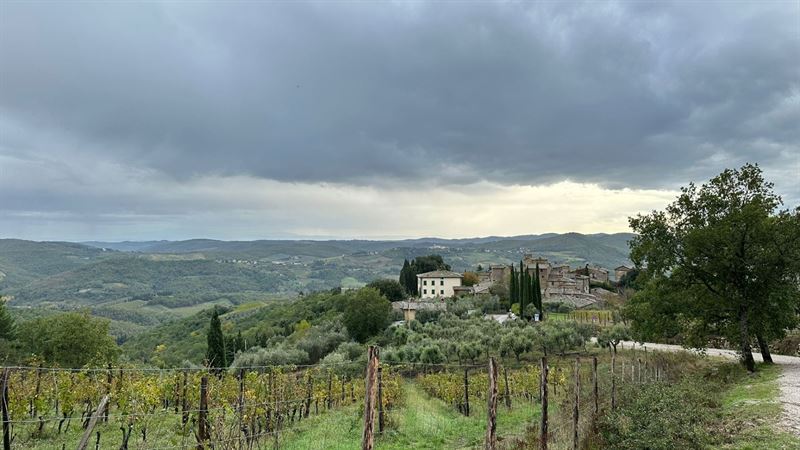
Top Things to Do
Tiny Volpaia makes a quiet and timeless base that is hard to leave, despite the limited range of obvious activities on tap. The hamlet lies just off the Chiantigiana, the Chianti Way wine route, so is well-placed for forays to neighbouring Chianti bastions, such as Radda and Castellina. If you are a culture-lover, also consider day trips to San Gimignano, Siena and Florence, all within reach.
This is just a taster to the Chianti. See our specific guides to top Chianti outposts, all accessed through our Destinations listings, For starters, check out our guides to Greve, Panzano, Castellina, Radda and Castelnuovo Beradenga. Our additional Chianti guides cover Castagnoli, San Gusme, San Donato in Poggio and Vagliagli. -
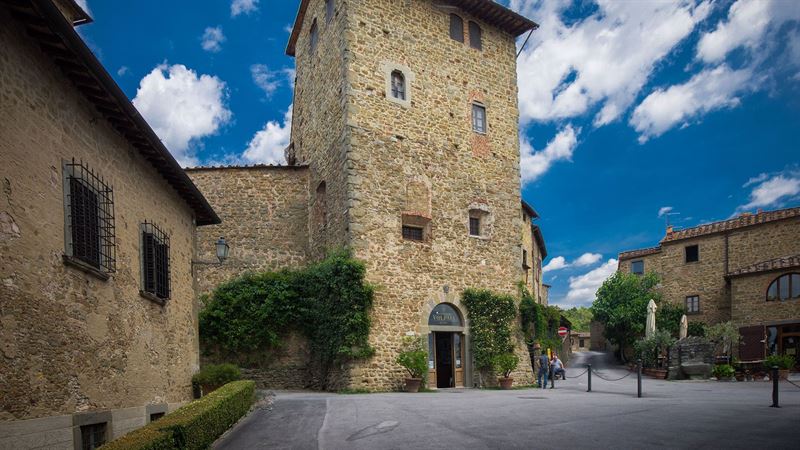
1. Visit Castello di Volpaia
Castello di Volpaia is far more than a winery: it’s the hub of a sustainable community. Its success shows that medieval villages can be saved and repurposed for modern living. It’s done almost invisibly, without sacrificing the soul of the village or even its surface sheen of antiquity. Nor has the village sold out to outsiders: the locals are in charge, even if tourism sustains their way of life. The Castello di Volpaia’s owners, Carlo and Giovannella Stianti Mascheroni, own about two-thirds of the village, not just the winery. Theirs is a long-term project, to keep this medieval hamlet alive for future generations. To this end, most of the estate workers have been housed within the village walls. Given its agricultural lands, the village is virtually self-sufficient. This is a sustainable community at its best.
Volpaia was founded in 1172, with its redoubtable castle acting as a defensive outpost for the Florentine Republic against Siena. Today, this battered castle acts as the hub of a successful wine estate that has saved the village from ruin. Medieval buildings, deconsecrated churches and underground passages have been quietly converted into high-tech wine cellars or olive oil mills, with bottling plants and olive presses. Parts are connected by ingenious underground tunnels. An underground labyrinth of steel pipes runs below the village. Known as a wine-duct, this maze of pipes allows the wine to move by means of gravity from higher to lower parts of the village.
The Castello di Volpaia cellars start from a sacristy and end up in cellars below churches which are now given over to wine-making. Plan ahead and book a tour and tasting with Castello di Volpaia for a behind-the-scenes experience. The wine-tasting shop is housed in what was once the main tower of the ancient castle. The barrels of wine are aged in cellars beneath ancient village buildings, such as the churches of San Lorenzo and the Commenda di Sant’Eufrosino. After bottling in a high-tech plant, the precious wine continues to age in the bottle in the dark, cool cellars below Palazzo Canigiani.
All this would be nothing if the wines themselves didn’t deliver. The estate’s standard Chianti Classic Riserva is elegant, with aromas of black cherry, tobacco and leather. Instead, Coltassala is a pricey Chianti Classico Riserva of great complexity which some have likened to a Super Tuscan. Enraptured reviewers talk of “aromas of salami, fennel bulb, peppercorns and wildflowers.” The estate also produces an entry-level Chianti Classico, made with ten percent Merlot, which is lightly tannic but not overly oaky. Finally, there is also a smooth Super Tuscan blend called Balifico that boosts the portion of Cabernet Sauvignon. Book a visit to the olive press and wine cellars, with a tasting of Volpaia wines and olive oil along with a sampling of local produce. Castello di Volpaia honey, speciality vinegars and Extra Virgin Olive Oil are also on sale. Cellar visits are usually conducted at 11.30am, 3pm and 5pm but it’s best to check directly.
Address: Castello di Volpaia, Piazza della Cisterna, Volpaia, 53017, Radda in Chianti
Tel: +39 0577 738066
Web: www.volpaia.com -
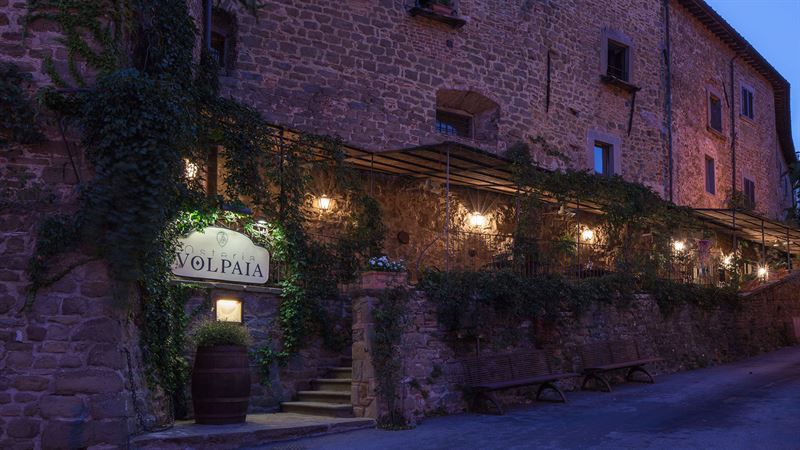
2. Creative dining in L’Osteria Volpaia
Volpaia is lucky enough to boast several decent inns, both on the main square, and both serving traditional Tuscan home cooking. Instead, L’Osteria Volpaia seeks to surprise rather than to soothe. This is a games-playing gourmet restaurant that aims to deconstruct Tuscan staples. Even so, this gastro-inn is not so much faddish or whimsical as seeking to reconfigure Tuscan ingredients in tantalising new ways. The creative cooking relies upon the freshest local ingredients, often from the estate’s kitchen gardens or vineyards, all owned by the same local landlords. The family owners are fully committed to sustainable practice and follow this through in both the restaurant and wine estate.
This gastro inn reinterprets Tuscan produce in novel ways. In the cannellini bean ravioli with saffron and sour cream, a typical Tuscan side dish of white cannellini beans is transformed into a puré in a saffron sauce marbled with sour cream. The chef’s tribute to Tuscan ribollita soup becomes a mix of black cabbage and ricotta balls served with local finocchiona salami made with fennel seeds. Other dishes include a wild boar and olive risotto and, for dessert, cantucci mousse, goat’s cheese ice cream and Vin Santo coffee caramel. L’Osteria naturally serves organic wines from Castello di Volpaia. Prices are fairly high but reasonable, given the sheer inventiveness and the quality of the ingredients.
Address: Vicolo della Torre 2, Volpaia, 53017 Radda in Chianti
Tel: +39 0577 738066
Web: www.osteriavolpaia.com -
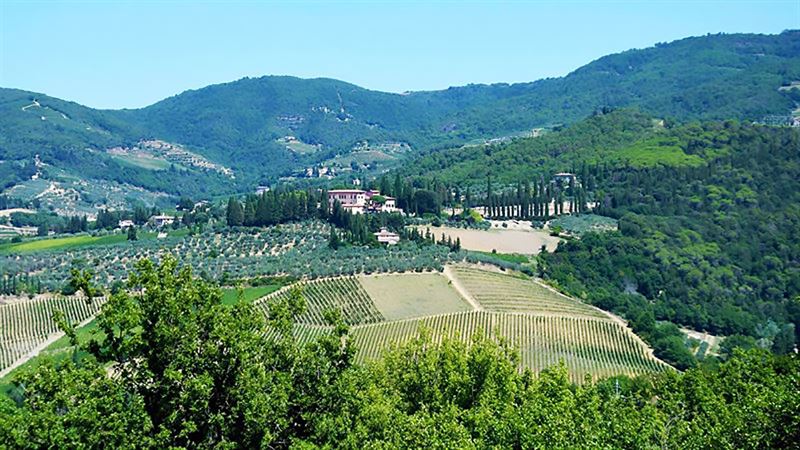
3. Vignamaggio – Renaissance villa estate and gardens
Vignamaggio, a magnificent Renaissance villa estate, is linked to great art. Set north of Volpaia, the wine estate is delightful enough to have starred as a film set, based on Shakespeare’s Much Ado About Nothing. The romantic villa lords over its Italianate gardens and vine-clad hills. The serene landscape supposedly inspired Leonardo da Vinci. The castle was remodelled as a patrician villa in the 14th century and belonged to the Florentine Gherardini family. Monna Lisa Gheradini, better-known as Leonardo da Vinci’s Mona Lisa, married into this family in the 14th century. The villa boasts a crenellated tower, 16th-century corbelled arches and courtyard, with the top of the tower remodelled in Neo-Gothic style.
Centred on the lovely Renaissance villa, this tenuta is an established 65-hectare wine estate, and one of the oldest in Tuscany, dating back to 1404. The award-winning wines range from Chianti Classico and trendy Super Tuscans to a fresh Rosé, a Cabernet Franc, Vin Santo and grappa. Orchards, herb gardens, wheat-fields and thirty hectares of olive groves reflect the estate’s commitment to biodiversity. The villa grounds showcase Italianate, Renaissance-style gardens, complete with cypresses, clipped box parterres and rose-draped statuary. French owner and architect Patrice Taravella has recently spruced up the grounds, adding orchards, classical pool fountains and pergolas.
Vignamaggio now offers garden and cellar tours, as well as a free wine-tasting. The farm-to-table Ristorante Monna Lisa means much of the produce comes from the surrounding organic estate. Wine-pairing lunches are on offer, as are guided tours of the estate, ending in a sunset dinner. The seasonal menu celebrates Tuscan produce, from vegetable platters drizzled in home-produced olive oil to pasta with pistachio and garden-mint pesto. The pork and cured meats come from the estate's happy herd of cinta senese pigs.
Address: Via Petriolo 5, 50022 Greve in Chianti
Tel: T: +39 055 854661 (general) & T: +39 055 8546624 (tours & tastings)
Web: www.vignamaggio.com -
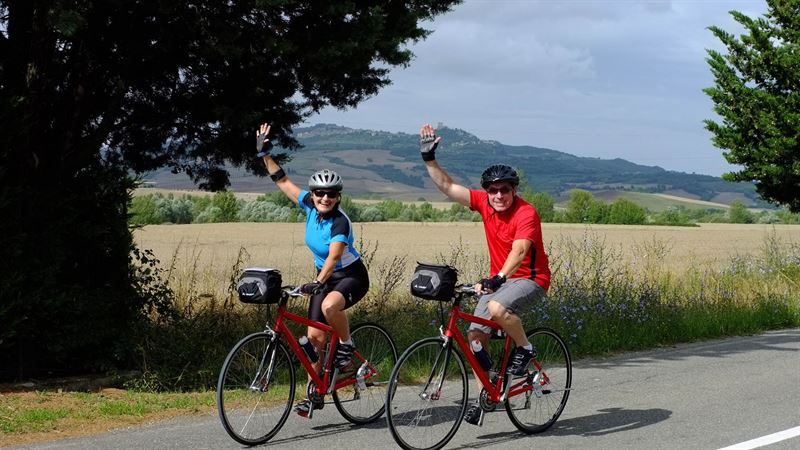
4. Easy e-bike rides through the Chianti
This is cycling country so make the most of it, even if you are not a fitness fiend on a racing bike. The reason the Chianti is so scenic is because it's so hilly. If you lack thighs of steel or the desire to face steepish ascents, then consider an e-bike. Based in Gaiole, south of Volpaia, Tuscany E-bike Rental run guided or self-guided e-bike tours in the Chianti area. These power-assisted bicycles are easy to use, even for first-timers. On downhill slopes, they work like a conventional bicycle but on long, flat runs or if you’re going uphill, the electric motor cuts in and provides the help you need to reach your destination without breaking into a sweat. The e-bikes can be rented for as little as an hour or as long as a week.
One typical guided route from Gaiole could take in the rolling hills of the Chianti, the Castello di Brolio and distant views of Siena. All this including a light lunch and simple wine-tasting on an atmospheric estate. This particular tour is a three-hour, 46 km affair reaching an altitude of 518 metres. There are plenty of easier or more challenging routes that can be suggested.
Address: Tuscany E-bike Rental, Via Roma 82, 53013 Gaiole in Chianti
Tel: T: +39 0577 749355. Mob: +39 335 5237021 (Carmine) & +39 338 3652166 (Enrico)
Web: www.tuscanyebikerental.com -
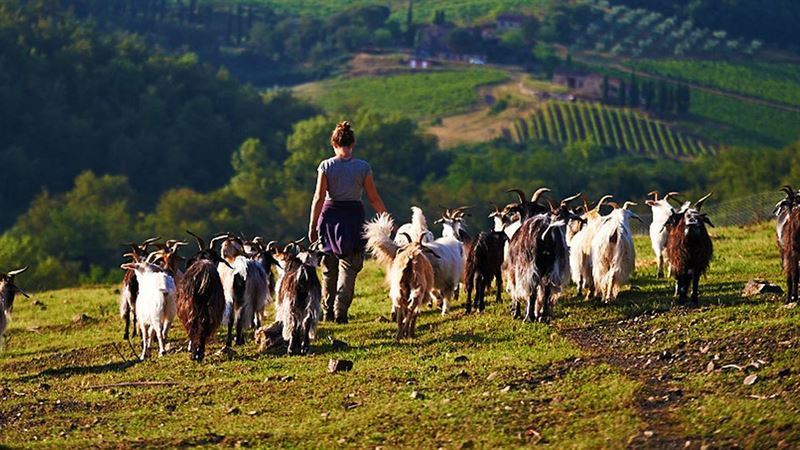
5. Chianti Cashmere Goat Farm
If you’ve got young children in tow or are simply tired of wine estates, then visit a quirky Chianti Cashmere Goat Farm, north-west of Gaiole. Run by American-born Nora Kravis, this long-established cashmere farm goes from strength to strength. It’s fun but also represents sustainable farming at its best. Founder Nora Kravis left New York’s Long Island for Italy long ago and never looked back. She knows all the shepherds, herders, growers and weavers and cares for her goats as if they were family. At this stone farmhouse with a view, the kids can hold, pet and bottle-feed the kid goats. The goats are guarded by fluffy white Abruzzo shepherd dogs who act as guard dogs to keep any wolf pack at bay.
After getting your fill of cute goats and puppies, turn your attention to the cashmere itself. In colour, the superior cashmere goats are shades of cream, hazelnut, brown, grey and charcoal so the yarn can be used undyed in its original shade. Cashmere is the fine, fluffy, downy undercoat produced by a cashmere goat and is apparently ten times lighter and warmer than wool. Knitters can choose some lovely fibres and sustainable cashmere yarn. You can also buy home textiles hand-made in Tuscany as well as hand-woven, scarves, shawls, throws, hats, socks and baby blankets.
If you’re won over, the farm can organize spinning, weaving, knitting or embroidery classes with local Italian artisans who already work with them. Best of all, there’s the new `be a shepherd for the day’ experience. This is fun for all the family, with full-immersion in the life of a cashmere goat shepherd. Guests get to accompany a herd of goats through the fields and woods surrounding the farm, stopping for a wine-tasting at a neighbouring farm, and coming back to the cashmere farm for a lavish farm lunch. The farm and gift shop are open in the afternoon from Easter to October.
Address: Chianti Cashmere, Azienda Agricola La Penisola, La Penisola, 53017, Radda in Chianti
Tel: +39 0577 738080
Web: www.chianticashmere.com -
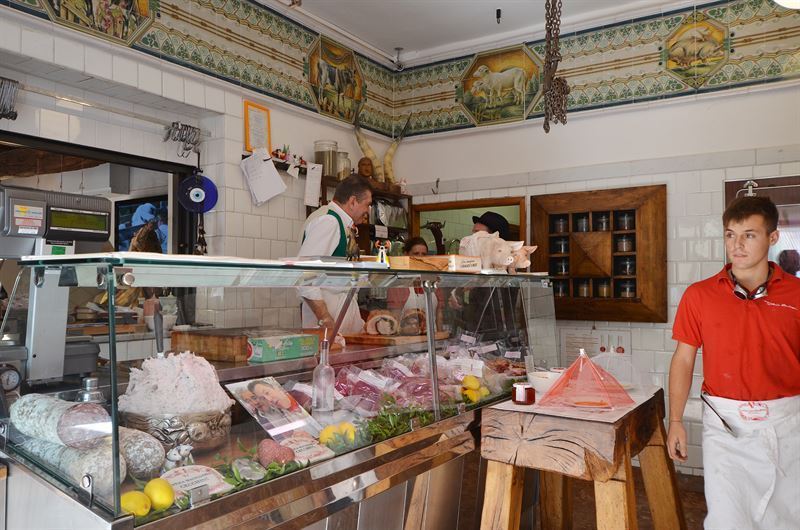
6. Indulge in a meat fest in Panzano
Panzano, west of Volpaia, is the place to indulge in a passion for Tuscan meat, including Florentine T-bone steak. Panzano is the meaty preserve of Dario Cecchini, a cleverly eccentric celebrity butcher with a mini empire in these parts. No one can wield a bloody meat cleaver better, still less while reciting Dante. Part butcher, part showman, Dario keeps his audience entertained as well as over-fed.
With several restaurants in town, all clustered round his famous butcher’s, Cecchini is still doing a brisk trade. The restaurants are fairly priced so there’s no sense of being caught in a tourist trap. The winning format appeals to most visitors, as does the conviviality and showbiz side.
T-bone steak predominates, at least in one restaurant. For any beef-loving Tuscan, bistecca alla fiorentina – a huge, tender T-bone steak, grilled over an open fire and seasoned with nothing more than crushed pepper¬corns, salt, and a hint of garlic and olive oil, served very rare – is the ultimate steak. Bear in mind that all is not bleak for vegetarians: there are strong meat-free menus for those of a more squeamish disposition. Basic wine is included in the price but you can also bring your own.
See our Panzano Eating & Drinking guide for full suggestions.
To work up an appetite, walk to the Pieve di San Leonino, Panzano’s loveliest church, set on a hilltop just outside the village. Inside the Romanesque pieve are precious artworks, including della Robbia terracotta tabernacles and a medieval triptych of the Virgin and Child. -
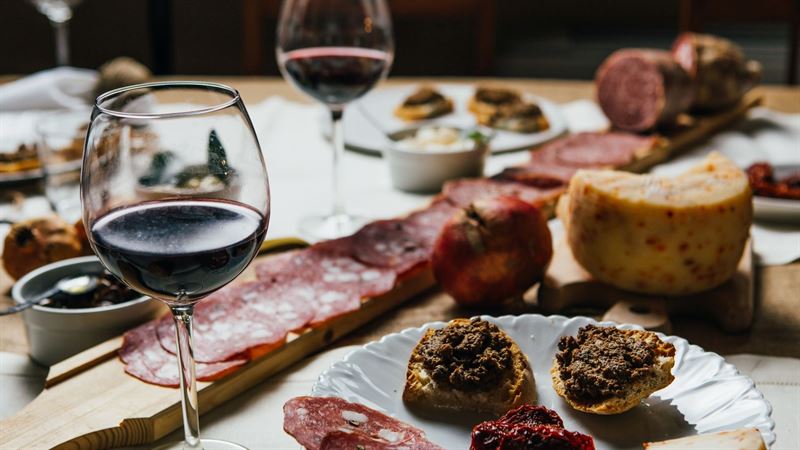
Eating and Drinking
-
Castello di Volpaia
Wine is the lifeblood of the village so sample the Castello di Volpaia wines, if only to learn how ingenious their methods are. At harvest time, the wine-ducts across the village are used to connect various buildings — a medieval-meets-modern way of gravity-flow wine-making. Book a visit to the Castello di Volpaia olive press and wine cellars, with a tasting of estate wines and olive oil, along with a sampling of the local produce. Castello di Volpaia honey, speciality vinegars and Extra Virgin Olive Oil are also on sale. Cellar visits are usually conducted at 11.30am, 3pm and 5pm but it’s best to check directly.
Castello di Volpaia, Piazza della Cisterna, Volpaia, 53017 Radda in Chianti
T: +39 0577 738066 & www.volpaia.com
Our other recommended wine estates are featured in each of the individual Chianti guides. As for dining, with only a trio of dining options in the village, all recommended, and listed below, you will also need to explore slightly further afield.
Within the village, L’Osteria Volpaia is the creative, fine-dining option but the other two options are genuine and unpretentious. Tuck into platters of local cheeses and cured meats at a simpler inn or sample the olive oil, honey and vinegars made by the local Castello di Volpaia wine estate.
This is just a taster to the Chianti. See our restaurant recommendations below and also see our other guides to top Chianti towns and villages, all accessed through our Destinations listings. -
La Bottega
Set on the main square in quaint Volpaia, this delightful family-run inn serves special but unfussy Tuscan dishes. These mid-priced dishes are complemented by sound Chianti Classico wines, along with salads and vegetables from the kitchen garden. Mid-priced dishes include hand-rolled pasta or ribollita soup followed by wild boar or Florentine T-bone steak. To be sure of grabbing a table on the shady terrace, book ahead and enjoy the view from the hilltop hamlet over the timeless countryside below.
Address: Piazza della Torre 1, Volpaia, 53017 Radda in Chianti
Tel: +39 0577 738001
Web: www.labottegadivolpaia.it -
Bar Ucci
Also set on the main square in Volpaia, this exceptionally friendly spot is a cross between a wine bar and a simple, homely inn. The stone building began as stables, with horses on one side and sheep and goats on the other. It’s family-run, with granny making the cakes and tarts. On the menu are good-value salads, platters of cured meats or cheeses, panzanella bread and tomato salad, or spicy tomatoes on crostini. For something more filling, choose the beef stew or wild boar with pappardelle pasta. The wines range from simple estates over the next hill to Castello di Brolio vintages.
Address: Piazza Della Torre 9, 53017 Volpaia, Radda in Chianti (SI)
Tel: +39 0577 738042
Web: www.bar-ucci.it -
L’Osteria Le Panzanelle
Set south of Volpaia, on the road between Radda and Panzano, this is a bastion of Tuscan home-cooking. With its white-washed walls, it’s an unpretentious but utterly reliable country trattoria. Come for the home cooking, friendly service, short but seasonal menu and the extensive Tuscan wine list. Tuck into the roast rabbit, the pumpkin ravioli or any pasta in wild boar sauce. End with the panna cotta or the homemade, crunchy cantuccini biscuits, ideally dipped in Vin Santo.
Address: Localita Lucarelli, 53017 Radda in Chianti (Si)
Tel: +39 0577 733511
Web: www.lepanzanelle.it -
La Casa Porciatti
This homely wine bar is tucked into an early 14th-century building in the heart of neighbouring Radda in Chianti. It also doubles as a good-value inn and wine shop. Along with a wide selection of Tuscan wines, you can tuck into taglieri, platters of home-cured meats or cheeses, along with porchetta (roast suckling pig). For something more substantial, choose stubby pici pasta with a meaty ragù sauce, ravioli with black truffle or hearty ribollita soup. Florentine tripe, wild boar stew and Sienese ossobuco are also on the menu.
Web: https://casaporciatti.it/ -
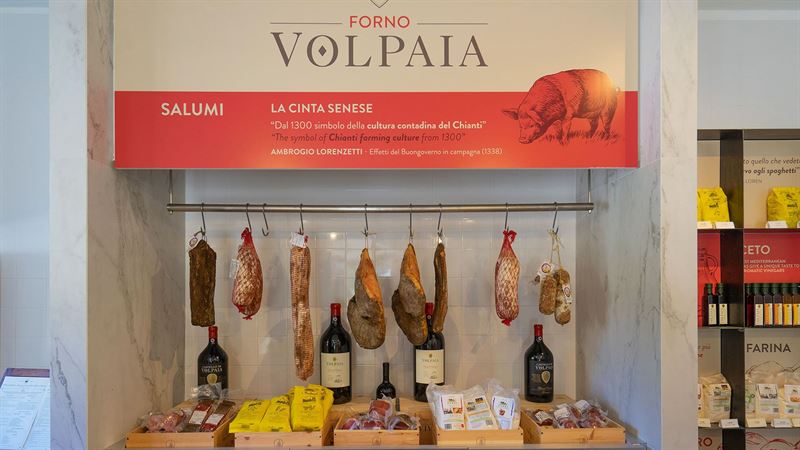
Shopping
Shopping in this fortified village is very limited but special. It all centres on produce from the agricultural and wine estate of Castello di Volpaia. The estate wines range from Chianti Classico and Chianti Classico Riserva to Coltassala, Balifico, Bianco di Volpaia and Vinsanto. All can be tasted and purchased at the estate enoteca, the tasting shop. For more shopping options, head to neighbouring Radda and Castellina.
To enjoy the full experience and intriguing history of the estate, book a visit to the olive press and wine cellars. This is best linked to a tasting of Volpaia wines and olive oil, along with a sampling of the estate honey and speciality vinegars. Cellar visits are usually conducted at 11.30am, 3pm and 5pm but it’s best to check with the estate directly.
Address: Castello di Volpaia, Piazza della Cisterna, Volpaia, 53017 Radda in Chianti (Si)
Tel: +39 0577 738066
Web: www.volpaia.com -
Luxury designer outlets
For a complete change of scene, designer shopping fans could head to the luxury outlets in the Valdarno area. The Mall Firenze is a thirty-minute drive east from Florence, on the Pontassieve road. There’s also a direct shuttle bus there from Siena. After browsing the designer brands, end your shopping experience in the Mall’s Gucci café and restaurant.
Address: The Mall, Via Europa 8, 50066 Leccio Reggello
Tel: +39 055 8657775
Web: www.themall.it -
Parking & Getting around
The parking in Volpaia is outside the walls, in the free car park along Strada Provinciale (SP) 112, just below the small village. Note that most Tuscan towns operate a strict ZTL system, a Limited Traffic Zone. This means that the Centro Storico (historic centre) is essentially closed to traffic, particularly for non-residents. Cars will need to be left outside the walls. That said, the Chianti towns are small so present far less trouble than such cities as Florence and Siena. Parking tips: for advice on individual Chianti places, please see our individual Destination guides, including those on Greve, Panzano, Castellina, Radda, Gaiole and Castelnuovo Beradenga.
Advice on ZTLs: You may see other cars crossing the ZTL boundary (Limited Traffic Zone) and assume you can proceed. Not so. The drivers crossing into the ZTL zone will probably be locals and have residents’ permits. Visitors do not so are liable to fines. Zones are monitored by cameras, so tickets are issued immediately and automatically, as soon as (and each time) the car crosses the ZTL boundary.
-
Getting around
The Chianti can be delightful driving country. Its appeal lies in the rolling countryside, array of vineyards and olive groves, relatively quiet roads, and the mix of small medieval towns. Public transport in the Chianti is rather sporadic so car hire makes the most sense if you want to explore the area properly. Driving in the Chianti can be deeply enjoyable experience, especially with a detailed map or GPS navigator to hand. For a great day out, try a customised tour with Chianti Taxi.
Greve, the main gateway from the north, lies on the SR222, commonly known as the Chiantigiana, about 30 km south of Florence and 40 km north of Siena. From Greve, the scenic Chiantigiana meanders through the Chianti, passing through most of the typical villages. This is a charming route to take by day. At night, however, you might encounter wild boars, porcupines or deer crossing the road.
From Florence and the Chiantigiana head towards Greve, then further south to Radda and Gaiole. Or pick up the Florence-Siena Raccordo Autostradale highway (known as the RA) and take the San Donato in Poggio exit before following the SP101, which becomes the SP76.
From Siena, leave town on the fast Florence-Siena Raccordo Autostradale highway (known as the RA), taking the Badesse exit for the SP 119, which becomes the SR222, the Chiantigiana. Or take the quieter, slower route from Siena: take the SR2, which becomes the more tranquil SR222 until Castellina and then onto Radda and Gaiole.
By private tour: Chianti Taxi, a reliable Panzano-based transport service offers day-long private tours around the Chianti and beyond. These are customised tours that can take in everything from olive oil mills and wine estates to Pecorino farms and hand-painted ceramics. With his comfortable minivan, owner Daniele Mogni has the inside track on what you can do in the Chianti. It’s worth splashing out for a day so you can relax and drink your fill at the wine estates.
Chianti Taxi. T: +39 389 8160050 & www.chiantitaxi.com
The Chianti by train: this is not an easy place to reach by rail. The train service barely touches Chianti's attractions, which is part of the reason why the area is so peaceful. The main Chianti station is Castellina in Chianti, which is on the Siena-Florence line but you need to change trains at Empoli.
The Chianti by bus: Buses connect Florence to Greve and Panzano but end there. These buses often provide a more useful service than the trains but the confusing 365 bus service (T: +39 800373760, freephone only & www.acvbus.it) still means that bus schedules are not always convenient and also operate a limited service on Sunday. Buses also connect Siena and Castellina: a Tiemme bus service (T: +39 0577 204111 & www.tiemmespa.it) operates around 7 services a day. Buses also connect Castellina and Radda: a Tiemme bus service (T: +39 0577 204111 & www.tiemmespa.it). Buses also connect Siena and Gaiole: a Tiemme bus service (T: +39 0577 204111 & www.tiemmespa.it).
On your bike: The Chianti is a lovely place to explore by bike. The combination of romantic Tuscan scenery and challenging gravel roads is what makes it enjoyable. The cycling races in the region also attract big crowds. Whether as a spectator or a participant, L’Eroica is worth following. This renowned amateur event that allows cyclists from around the world to experience the region while riding classic bikes.





















